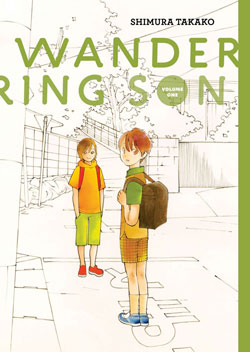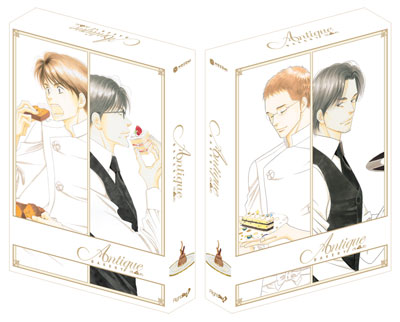
Logo handmade by Bannister
Column by Scott Green

Manga Spotlight: Wandering Son
Volume 1
by Shimura Takako
to be released by Fantagraphics July 5, 2011
Wandering Son (or "Hourou Musuko," worth pointing out because the anime adaptation is legally streaming under that name) follows the adolescence of Shuichi Nitori, a feminine boy who finds himself wishing he was a girl and Yoshino Takatsuki, a tall girl who similarly finds herself drawn to a masculine identity.
I wouldn't say that Wandering Son is "outside my comfort zone." There is some pandering in series like DearS that makes me uncomfortable, but, beyond that, I wouldn't say that anything from the maggots and sores of Hideshi Hino manga to full bore foodie-ism of Oishinbo are outside my comfort zone... well, maybe some of the nationalism of the latter doesn't sit easily.
On the other hand, I'm generally not exactly keen to read the story of an adolescent finding their identity, unless the manga in question is draped in genre. If it's presented with Kazuo Umezu shocks or the subject is finding themselves by training to be an MMA competitor, I'm all over it. On the other side of my preferences, if the characters are a decade or so older, I'm far less fussy about genre. And, not just male audience targeting, seinen, I've remained fascinated by josei. The issue is that straight stories of characters the ages of Wandering Son's struggling to establish their identities don't pique my interest.
I used to make time for manga that explored that territory. There was a point when Oh! My Goddess passed for a spot of naturalistic drama in manga's North American footprint. When manga began booming and began offering more than Ghost in the Shell, Blade of the Immortal and Battle Angel Alita, one of the calling cards that the media began to establish was its willingness to deal with personal, often taboo subjects. Frederik L. Schodt's Manga! Manga!: The World of Japanese Comics was mandatory reading, and we all picked up on the narrative of how Osamu Tezuka kicked off proto-shoujo with works like Princess Knight, the fairytale of a girl who assumes the identity of a boy to inherit her kingdom’s throne and of the Phantom Knight to fight for justice. This thread of manga was then revolutionized when women began writing manga for female audiences, in particular, the Year 24 Group, with artists like Moto Hagio and Riyoko Ikeda who had am interest and willingness to explore sexuality and gender in manga like The Rose of Versailles, the story of a girl raised male to take her father's place in the French Royale Guard in the time leading up to the revolution.
This is a bit reductive, but the echo chamber form by limited sources is deserving of more of the blame than Schodt's work.
With Moto Hagio collections like Drunken Dream and the upcoming release of Princess Knight, it looks like North America is finally starting to get some of these foundational works. (Though, they aren't entirely new to the territory. In the mid 90's, Viz did release Moto Hagio's A'A, as well as the Four Shoujo Stories collection of work by Hagio Moto, Keiko Nishi and Shio Sato; apart from an excerpt in Manga! Manga!, Rose of Versailles will be unavailable in English for the foreseeable future).
But, North America did get plenty of their descendants. Teen tribulations fill the book store shelves, some more profound and some more engaging that others. When the boom hit, they were distinctive. I certainly wasn't reading from that niche outside manga. Then, about the time that I lost the ability to identify every manga in Diamond's shipping list, I began hitting a lot of samey books and a lot of mediocre ones. One of the victims of manga's boom and subsequent bust (along with important things like jobs) was the perception of manga itself. I certainly began to take manga's willingness to broach touchy subjects for granted and allowed titles about certain subjects and from certain genres to blur.
I'm not saying that shoujo should be ignored, I'm saying that in the glut of media choices, I am guilty of of ignoring it, and apart from classics like the (relatively) recent release of Hagio Moto's Drunken Dream and the upcoming Princess Knight, I'm honestly not terribly motivated to correct this.
And, here's where I immolate myself in the eyes of shoujo fans...
I can't imagine that Wandering Son is no way informed by that shoujo tradition, from Princess Knight, through the Year 24 Group and so on any more than I can imagine that a gangster movie is no way informed by the godfather. And, I don't think it's entirely wrong headed for someone to think of it as shoujo. That said, it's not. More than that, what I like best about it is what distinguishes it from the majority of at least mainstream shoujo.
Wandering Son ran in Comic Beam, home to a line up eclecticly ranging from Junko Mizuno’s Little Fluffy Gigolo Pelu to Victorian maid romance Emma. - What's been called "unusual, quirky, experimental and fun/weird" - "Monthly Comic Beam A Magazine for the Comic Freaks!"
It's not that what is done here couldn't be done in shoujo. There aren't iron clad rules against it. But it's unlikely. Both shounen and shoujo tend to trade in aspirations. Yet, while Wandering Son does frame its subjects desire in terms of wishing and dreaming, it's not the same sort of pursuit. There's no defined process, and if there are rules or formulas, its character certainly don't know them.
Maybe clothes make the person, and the manga is very aware of a tradition of cross-dressing, with Takatsuki's father being identified as a fan of Takarazuka (performance troupe famous for its female cast playing both genders) and a school project involving Nitori and Takatsuki's class putting on a reverse gender version of Rose of Versailles (so, the protagonist Oscar would be a boy playing a girl who has assumed a male identity). Biology kicks in and that certainly complicates any sort progress based of what's being worn, but it was never that simple to begin with.
Wandering Son is kids trying to figure out their identities and reconcile what they figure out with the rest of the complexities of their lives. It does this in a way that is not bound by conventions or formulas. There isn't a goal or routine governing the characters. There aren't parameters to block out a well defined maze for them to stumble through.
That's the way that Takako Shimura structures the narrative, but, more than that, it's how she reflects the age of her subjects. The characters aren't just tween to offer the audience an identifiable frame of reference. Most Comic Beam readers were going to be older, in some respects, putting Wandering Son in the school of manga that encourages the reader to reflect back on how they saw the world at a younger more innocent age. But, there's significance to the character's ages beyond that.
These are fidgety kids. They're often inarticulate, and, more than that, they are not practiced in the best course of dealing with impulses or interactions. Rather than high drama, most of the manga's static comes from trampling that is accidental or without a huge amount of malice. For example, Takatsuki gets picked on, and it's effectingly hurtful, but there's also the sense that the bully is really a kid who hasn't managed some bad impulses. This makes for an unusual tone. At once, it's "nice" in the way that a story about young people simply being young people could be called "nice." And, at the same time, it's difficult not to pick up some unease watching these characters engage in potentially difficult interactions without the tools that they'll eventually need.
At lease superficially, Wandering Son looks like the kind of manga that I rarely make time for. Not to say that that's a defensible approach, but, aside from whether I should be reading more modern shoujo, the point is, Wandering Son smartly works a distinctive point of view, without allowing itself to be encumbered by convention. Beyond being effecting, with an interesting point of view, you will not find much in the way of its like elsewhere. That makes it precisely what I'm into, and precisely what I hope AICN readers are into.

Anime Spotlight: Antique Bakery
Complete Collection
Released by Right Stuf
In it's own way, Antique Bakery might be one of the weirdest anime ever.
Antique Bakery is a decidedly different proposition from Wandering Son. Not some new exercise in its own space, it's fans know what they should be receiving from it. There's cute guys getting intimate, coupled with food porn.
For my part, I don't love the appeal markers. For example, to nail the pun, dessert talk is certain to glaze over my attention. That being the case, I can certainly appreciate anime serving its audience. I've previously said that I forgive works of dubious merit provided that that they have good action scenes. However, the equation laid out in Antique Bakery isn't that simple. It can be tight fisted in its way. It's inclined to give the characters some degree of privacy, though, part of the game is that author of the original manga, Fumi Yoshinaga went more explicit in doujinishi she created of her own work. This isn't to say that Antique Bakery doesn’t deliver. I mean, there's a scene of guys who bunk at a boxing gym crouching over a character, salivating because he smells like cakes. Nor is it to say that restraint is a chief virtue in and of itself.
Describing Antique Bakery's attitude could be said to constitute a spoiler, yet what's significant and what's interesting about the series is the way in which it's not settled, but settling down in its skin... a bit content, a bit sad.
Antique Bakery offers the kind of configuration of characters that you wouldn't blink at in anime or manga, but which is pretty gobstopping on paper.
The ever distinctive voiced Norio Wakamoto keeps popping is head in as a dessert connoisseur/retired detective, and that's not not funny, but keep in mind that while Antique Bakery is far from humorless, all of this is presented seriously.
As a child, Keisuke Tachibana was kidnapped. It might have been assumed that this was due to his family's wealth, but the kidnapper only held Tachibana and shared cake with him every day. As an adult, he chose to use his family's resources to open a dessert bakery... maybe to meet women, maybe to lure in the kidnapper, maybe for another reason.
Tachibana hires the best pâtissier around, Yusuke Ono. Ono comes with a bit of baggage. First, his "demonic" qualities have presented a problem at his former places of employment as men, gay or initially straight, have come to violence fighting over him. Second, he has a history with Tachibana. Though not the same year, Tachibana and Ono attended the same high school. Ono fell for the older Tachibana, and the usually accommodating to a fault Tachibana was brutal in rejecting him.
Eiji Kanda, a young boxer with a sweet tooth and something of an anger problem, forced into retirement by a detached retina answers a help wanted sign - restricted to men due to Ono's discomfort with women. He ends up as an apprentice of Ono.
Finally, the group is joined by Chikage Kobayakawa, Tachibana's childhood friend - also the son of a family employee, who Tachibana's family supported, and who, mostly in jest, refers to Tachibana as "Young Master." He and Ono develop something of a romantic relationship.
The series goes for a developing, episodic structure. Episodes move from a start point to an end point. The titular Antique Bakery is prepared to be featured in a local news feature, the pâtissier who Ono apprenticed under turns up, some folks with an unexpected connection to Chikage travel through an episode, or on a zany, yet sad mission, the inappropriately thin Tachibana puts on a Santa outfit to deliver Christmas cakes, and, he'd like to think, cheer. And, the series itself definitely moves from one place to a destination.
That the series ends someplace different from where it started and that there was that distance traveled is significant. There are events and things do happened to these characters during the course of the series. Meanwhile, the principals, Tachibana in particular, return to what they said and did prior to Antique Bakery's establishment.
Yet, while there is an ending and, after a fashion, a satisfying resolution, Antique Bakery is not inclined to put a bow on it. The tiles are present to make Antique Bakery a slide puzzle... moving those pieces around to explain the circumstances of Tachibana's kidnapping, his escape and his hideous rejection of Ono... and, arriving at a resolution when those bits are put into place. Except, the pieces don't land in precise spots and as such, the series doesn't function by way of any of strict algebra. Though set up to look like one, ultimately, it's not a mystery or puzzle. It's more interested in sentiments and the directions in which is moves owe more to emotional development than exact factual circumstances.
This less sorted out approach serves to put a greater emphasis on the time that the quartet spend together, often preparing or serving lovingly rendered desserts. It's in that space that the anime serves what the primary audience is present to see. Never to a condescending or hacky extent, the series is defined by fulfilling the audience's expectations. After all, the Antique Bakery anime aired in Japam as part of Fuji TV's Noitamina block, which programs anime that would appeal to audiences who aren't traditionally anime watchers ( while manga appeals across the spectrum, anime typically has a far narrower range - kids and geeks). It is unmistakably playing into yaoi (homosexual male relationships, typically for a female audience) interests.
Though Antique Bakery aims, and succeeds, in serving an audience underserved by anime, for honest reasons, it doesn't fully close the yaoi deal. I can see fans wanting more in that respect. Some of the characters would want more too. However, neither get that. And yet, while Antique Bakery is defined both by appeal and restraint, it's not a tease and not a neither fish nor fowl situation either. Folks like me, or folks with a greater affection of yaoi, can appropriate that it's neither hard selling the character drama nor a fan service factory, yet has something genuinely interesting to do with the former. A love of yaoi and food are necessary ingredients for loving Antique Bakery and still, there's an approach to the characters to be engaged by regardless.
AICN Anime on Tumblr
